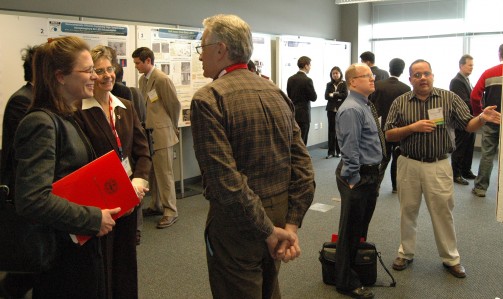Conference Explores Wide Range of Smart Lighting Applications

Nearly 120 participants from academia, government and industry attended “Smart Spaces: A Smart Lighting ERC Academia—Industry Day” at the Boston University Photonics Center on Feb. 8. Here, they enjoy a research poster session.
When the National Science Foundation Smart Lighting Engineering Research Center (ERC) was launched in 2008, one of its main objectives was to create an optical wireless network using LED-based visible light. While this remains a top priority, the Center has since explored several other applications of LED-based lighting systems, including boosting workplace productivity, detecting bio-terror agents and reducing energy consumption in buildings on the Smart Grid.
To explore such possibilities, nearly 120 participants from academia, government and industry attended “Smart Spaces: A Smart Lighting ERC Academia—Industry Day” at the Boston University Photonics Center on Feb. 8. Presenters represented the Smart Lighting ERC’s partner universities—Boston University, Rensselaer Polytechnic Institute and the University of New Mexico—and many other academic institutions in the U.S. and abroad.
View photos from the conference.
The meeting focused on “smart spaces” that integrate illuminators, sensors, controllers and communications technology into LED-based lighting systems that enhance and adapt to human needs and activities.
“Today’s revolution in solid state lighting yields efficiencies but is not very smart,” said Robert F. Karlicek, the ERC Director at Rensselaer Polytechnic Institute (RPI). “Part of the ERC’s vision for smart spaces is to be able to live in a world that’s directed by artificial light.” Karlicek announced major goals for the ERC that include the use of smart lighting for biochemical hazard detection, visible light communication and full-spectrum adaptive lighting.
Conference speakers described research on smart lighting applications that ranged from filmmaking to security.
For example, Stephen Selkowitz discussed how he and his team at the Lawrence Berkeley National Laboratory in California have been examining how smart lighting can improve efficiency and productivity in the workplace. The researchers introduced automated smart lighting systems to the 52-story New York Times Building in a design that includes sensor-controlled shades to reduce glare and more than 18,000 individually-dimmable fluorescent fixtures to supplement natural light.
“Workstation lighting was found to be more comfortable and more cost-efficient,” Selkowitz said, adding that the building saves 60 to 70 percent in energy costs.
Joel L. Plawsky, a professor of chemical engineering at RPI, explored how smart lighting can be used to purify air and water when used in photocatalysis, a process in which a catalyst harnesses UV radiation from sunlight and uses that energy to break down different substances including pesticides, microbes and nitrous oxide. To create a photocatalytic device, Plawsky and his team aim to deposit titanium dioxide nano-rods directly on a UV LED.
“Eventually, the goal is to build an autonomous photosystem,” he said.
BU Assistant Professor Hatice Altug (ECE) described how she is exploiting UV LED lighting, as well as multicolor LEDs, to detect individual viruses. Altug, Professor Thomas Little, Associate Professor Jeff Carruthers and other ECE researchers are spearheading smart lighting research efforts at the NSF Smart Lighting Center at BU.
Ten students from participating academic institutions, including BU computer engineering graduate student Michael Rahaim (PhD ’14), gave elevator pitches on their smart lighting-related research. Several others, including six student teams from the College of Engineering, presented their findings during a research poster session.
“These are our future colleagues,” ECE Department Chair David Castañón told attendees. “Take advantage of the opportunities to network with them.”
Prospects appear bright for these students as the smart lighting industry—already an estimated $50 billion market—continues to grow.
-Rachel Harrington (rachelah@bu.edu)
http://www.bu.edu/ece/2011/02/11/smart-lighting/

